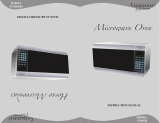
PRECAUCIONES PARA EVITAR AL POSIELE EXPOSICION
Siempre que utilizamos artefactos eléctricos se deben seguir precauciones seguridad, incluyendo las siguientes:
ADVERTENCIA - Para reducir el riesgo a quemaduras, shock eléctrico, fuego, lesiones físicas o la excesiva
exposición a la energía de microondas:
1. Lea todas las instrucciones antes de utilizar el horno microondas.
2. Lea y siga las "Precauciones para evitar la exposición excesiva a la energía de microondas" de la página 1.
3. Seleccione una superficie plana para colocar el horno microondas que provea suficiente espacio para las
entradas y salidas de aire. Se requiere un mínimo de 3 pulgadas entre el horno y alguna pared adyacente.
Uno de los laterales debe quedar al descubierto. Deje un mínimo de 3 pulgadas por arriba del horno
microondas. No cubra ni bloquee ninguna abertura del electrodoméstico. Este electrodoméstico debe ser
conectado a tierra. Ver "INSTRUCCIONES PARA CONEXIÓN A TIERRA" en pag. 4.
4. Algunos productos como huevos enteros y recipientes o potes sellados, por ejemplo, pueden quebrarse o
explotar, por lo tanto no deben utilizarse en este horno microondas.
5. Utilice el electrodoméstico solo para su entendido uso, como se describe en este manual. No utilice vapores o
químicos corrosivos. Este tipo de horno está diseñado específicamente para calentar, cocinar o secar
alimentos. No está diseñado para uso industrial o de laboratorio.
6. Como todo electrodoméstico, es necesario una estricta supervisión cuando es utilizado por niños.
7. Para reducir el riesgo de incendio en la cavidad del horno:
a. No cocine demasiado los alimentos. Cuidadosamente preste atención a papeles, bolsas plásticas u otro
material combustible que se esté utilizando para facilitar la cocción de algún alimento.
b. Retire los precintos de alambre de las bolsas plásticas o de papel antes de colocarlas dentro del horno.
c. Si los materiales dentro del horno comienzan a encenderse (prenderse fuego),
mantenga la puerta del horno cerrada, apague horno, desenchufe corte corriente.
d. No utilice la cavidad del horno para propósitos de almacenaje. No deje utensillos de cocina, productos
con papel o alimentos dentro del horno cuando no este en uso.
8. El hecho de calentar bebidas puede resultar en la ebullición de las mismas. Tenga cuidado cuando agarre el
recipiente.
9. No realice frituras de alimentos en el microondas. Es muy difícil controlar las grasas y puede result inflamable.
10. Pinche o realice pequeños cortes en alimentos con piel gruesa, como papas, manzanas, castañas, antes de
cocinar.
11. Debe revolverse o agitarse el contenido de mamaderas o jarras para bebes, y la temperatura debe ser contro-
lada antes de servir para evitar quemaduras.
12. Los utensillos de cocina pueden calentarse debido al calor transferido por los alimentos una vez cocinados. Es
posible que se necesiten agarraderas para sostener los utensillos.
13. No cubra o bloquee ninguna abertura del electrodoméstico.
14. No guarde u opere este electrodoméstico al aire libre. No utilice cerca de agua, por ejemplo cerca de la
mesada de la cocina, sobre una superficie húmeda, cerca de una pileta o situaciones similares.
15. No utilice este electrodoméstico en caso de que tenga el cable o el enchufe dañado, no funcione
correctamente, se haya dañado o caído.
16. No sumerja el cable o enchufe en agua. Mantenga el cable alejado de superficies calientes. No deje que el
cable cuelgue del borde de la mesa o mostrador.
17. Use solamente termómetros diseñados específicamente para el horno microondas.
18. No opere o ubique ningún electrodoméstico debajo del horno.
19. Asegúrese que la bandeja giratoria de vidrio y la guía de rodillos estén en su lugar cuando utilice el horno
microondas.
20. Reparación que involucre remover el cobertor o protector del horno microondas. En caso de exitir algún daño.
ADVERTENCIA: Es arriesgado para cualquier persona, salvo persona calificada, realizar el service o
reparación que involucre remover el cobertor o protector del horno microondas. En caso de existir algún daño,
no opere el horno y contacte a su distribuidor o un service autorizado.
GUARDE ESTAS INSTRUCCIONES
























